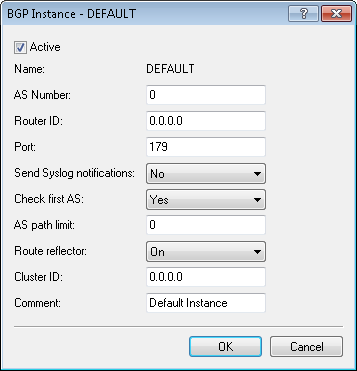You configure the BGP instance of the device under BGP instance.

- Active
- Activates or deactivates this BGP instance
Note: This setting only takes effect if BGP is activated on the device.
- Name
- Contains the name of the BGP instance.
Note: Since the device only supports one BGP instance at a time, this table contains one entry only, "DEFAULT".
- AS number
- The AS number assigned to this BGP instance.
Important: It is only possible to connect to a BGP router that does not support 32-bit AS numbers if you enter a 16-bit AS number here (less than 65536).
- Router ID
- The router ID (IPv4 address) of this particular BGP instance.
Note: The router ID must be unique among the neighbors of a BGP router.Note: When using IPv6 connections, you enter a fictional IPv4 address or any IPv4 address for the router here.
- Port
- Contains the port used by the BGP instance to listen to inbound connections from neighbors.
- Send SYSLOG message
- The device is able to store events, such as disconnects of neighbors associated with this BGP instance, to the SYSLOG. Use this option to enable or disable this feature.
- Check-First-AS
- Checks whether the first AS number in the AS path of received Update messages corresponds to the AS number of the neighbor. If this is not the case, this route is discarded.
Note: This check must be disabled if the router is connected with a BGP route server which, although it distributes routes, is not itself in the routing path and/or inserts its own AS into the AS path.
- AS-Path-Limit
- Maximum number of permitted AS numbers in the AS path of received Update messages. If the limit is exceeded, the device discards the route. An AS-Path-Limit provides protection against messages from incorrectly configured routers that advertise AS paths that are too long.
- Route-Reflector
- This specifies whether the router assumes the function of a route reflector. When operating iBGP, all of the BGP routers usually need to be fully meshed, i.e. each BGP router must have established a BGP connection to every other BGP router. A route reflector negates this requirement and enables iBGP routers to form, for example, a star-shaped topology. A route reflector forwards the iBGP routes to all of the route-reflector clients. A route reflector is able to serve route-reflector clients as well as normal BGP clients. In both cases no special configuration of the client is necessary.
- Cluster-ID
- Cluster-ID of the router in case it is configured as a route reflector. This is entered as an IPv4 address.
- Comment
- Comment about this BGP instance.
